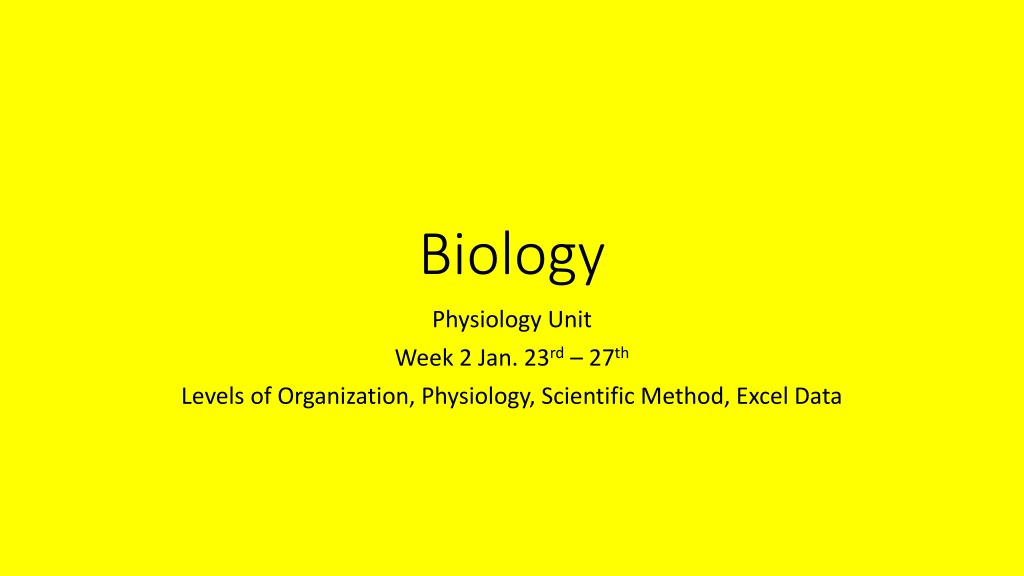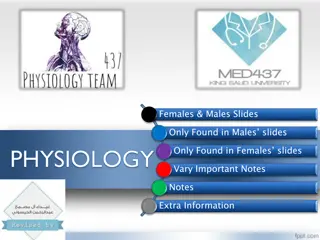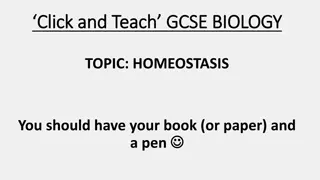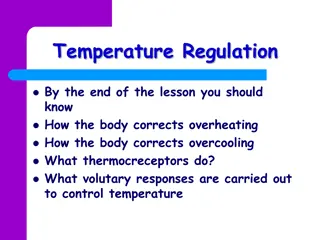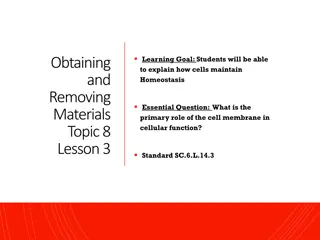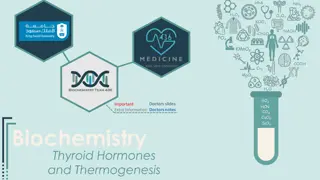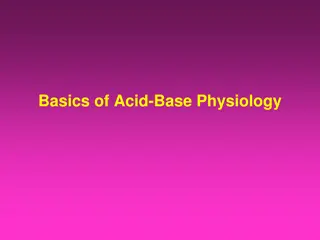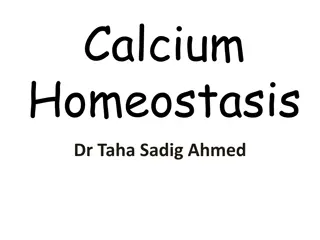Understanding Body Systems and Homeostasis in Physiology
Explore the levels of organization in biology, physiological systems, scientific methods, and data analysis in this week's unit. Delve into the concept of homeostasis, how body systems interact to maintain balance, and the key functions of various organ systems. Understand the importance of homeostasis in sustaining life and learn about common examples of maintaining internal equilibrium. Engage in identifying different body systems, cells, tissues, and organs, as well as the role of each system in maintaining overall health.
Uploaded on Sep 17, 2024 | 0 Views
Download Presentation

Please find below an Image/Link to download the presentation.
The content on the website is provided AS IS for your information and personal use only. It may not be sold, licensed, or shared on other websites without obtaining consent from the author. Download presentation by click this link. If you encounter any issues during the download, it is possible that the publisher has removed the file from their server.
E N D
Presentation Transcript
Biology Physiology Unit Week 2 Jan. 23rd 27th Levels of Organization, Physiology, Scientific Method, Excel Data
Show Biology Website Start working on Scientific Method Control vs. Variable Hypothesis Data: Dependent Variable vs. Independent Variable
1/23 Body Systems P. 1048 Obj: TSW Understand how body systems interact to maintain homeostasis. Pg. 12NB 1. Define homeostasis. 2. Name two body systems that you think of that interact to maintain homeostasis. 3. For each of the body systems you named in question #2, name a cell, tissue, and organ that make up that body system.
Homeostasis maintaining constant internal environment Examples and explanation of how the body maintains homeostasis: Body temperature 98.7 F, On a hot day you sweat. Water 70 75% You get thirsty after eating salty foods Salt Less than a teaspoon/day You crave salty foods. Glucose 80 120 mg/L in the blood Your energy picks up after you eat. Homeostasis is important because without the control of our internal environment we would not be able to live.
Introduction to the Physiology Systems P. 1048 BB Directions: Copy the Directions: Copy the 11 Body systems 11 Body systems down in your Notebook. Organ Systems of the Body and match the organ or functions to that system. Use the Internet or CH 34 39 in your biology book. P. 11 NB Circulatory Digestive Integumentary Lymphatic/ Immune Nervous Reproductive Skeletal Urinary/ Excretory down in your Notebook. Write the Endocrine Muscular Respiratory
Circulatory/ Cardiovascular Digestive Endocrine Integumentary Nervous Skeletal Lymphatic/ Immune Muscular Reproductive Urinary/ Excretory Respiratory 1. 2. Urinary/ excretory Rids the body of nitrogen containing wastes. Endocrine Is affected by the removal of the thyroid gland. 3. Skeletal Provides support & Levers on which the muscular system can act. Cardiovascular Includes the heart. Integumentary Protects underlying organs from drying out & mechanical damage. 4. 5. 6. 7. Immune Protects the body; destroys bacteria & tumor cells. Digestive Breaks down food into small particles that can be absorbed.
Circulatory Integumentary Nervous Skeletal Digestive Endocrine Lymphatic/ Immune Reproductive Urinary/ Excretory Muscular Respiratory 8. Respiratory/Circulatory Removes carbon dioxide from the blood. 9. Respiratory/Circulatory Delivers oxygen & nutrients to body tissues. 10. Muscular Moves the limbs; allows you to make facial expressions. 11. Urinary/Excretory Conserves body water or eliminates excess water/ waste. 12. Reproductive Provides for conception & birth. 13. Endocrine Controls the body with chemicals called hormones. 14. Integumentary Is damaged when you cut your finger or get a severe burn/ sunburn.
Circulatory/Cardiovascular Integumentary Nervous Digestive Digestive Endocrine Muscular Respiratory Lymphatic/ Immune Reproductive Urinary/ Excretory 15.Cardiovascular Blood vessels, Heart 16.Endocrine Pancreas, pituitary, adrenal glands. 17.Urinary/Excretory Kidney s, bladder, urethra. 18.Reproductive Testis, vas deferens, urethra. 19.Digestive Esophagus, Large Intestine, Rectum. 20.Skeletal Breastbone, vertebrae, skull. 21.Nervous Brain, nerves, spinal cord.
Goals of each Body System What is the function of the system? What are the cells, tissues & organs of the system? How does the system maintain Homeostasis? What other systems and does the your system work with? How does the how does your system work with other systems?
How to make a Data Table & Graph in Excel Activity Check out a Laptop. Log In Open Excel (Windows Office) New Spreadsheet Wait for McAllister to give specific instructions.
5 4 3 2 1 Picture or diagram of your system Detailed, complete, colored, labeled Detailed and complete. Colored Mostly complete, illustrates system, may be colored Does not illustrate the system. Not colored No effort Clear description/ function of your system and how it works Complete sentences, completely explains the topic in a few sentences Complete sentences, the topic is mostly clear, but the description has some components that are confusing Mostly complete sentences. Description is basic, leaves the audience with a few questions Incomplete sentences. The audience has many questions after reading this description No effort Diseases Clear description of possible diseases Description of some diseases mentioned One disease mentioned and described Response to prompt basic, not well explained Disease mentioned, no description No disease or problem mentioned Addresses specific prompt Prompt completely addressed Prompt mostly addressed Very little response to prompt Prompt not addressed organized Logical layout of poster. Titles, spacing good Logical layout Mostly organized, some components messy Some components organized Unorganized or random Strong effort good use of class time, 100% efficient Okay use of class time. On task most of the time Stated title, clear description of topic and discussion Occasionally off task Frequently off task Off task, poor use of time Presentation is clear and complete Stated title, clear description of topic and discussion. Ask for questions Good description of topic. Described topic, poor description or rushed Poor description of topic, missing components Everyone participated All members speak or explain examples Most members speak two members speak Only one member speaks Only one member speaks. Obvious lack of participation in group
Cardiovascular System (Take notes p. 39/41NB) Function: permits blood to circulate and transports gases (O2, CO2), waste, and nutrients to and from cells in the body; provides nourishment; helps in fighting diseases, stabilizes temp and pH Organs: endothelium, arteries, heart
Function: warms, moistens, & purifies air; inhaling and exhaling gases; helps body maintain stable pH by exhaling excess CO2, alveoli is where it is exchanged Organs: trachea, bronchi, lungs, nose Respiratory
Function: responsible for voluntary and involuntary control of the body and communication of all its parts Organs: brain, spinal cord, sensory nerves Nervous
Function: support, movement, protection, blood cell and immune cell production, calcium storage, endocrine regulation. Organs: bones, ligaments, tendons, cartilage Skeletal
Endocrine Functions: produce and secrete hormones that regulate growth, metabolism, reproduction, sleep, and mood. Organs: pituitary, thyroid, parathyroids, adrenals
Digestive Functions: Physical and chemical breakdown of food into molecules that are absorbed; water absorption; eliminates waste Organs: mouth, stomach, intestines, liver
Muscular Functions: movement of the human body; parastalsis (muscle contractions on tubular smooth muscle, i.e. the digestive system) thermoregulation; maintain posture Organs: Types - Cardiac, Smooth, Skeletal
Reproductive Functions: produce offspring; gonads produce hormones that aid in growth and development Organs: Female-ovaries, uterus Male-testis, penis
Urinary Functions: filters blood to produce, store, and eliminate urine Organs: kidneys, ureters, bladder
Integumentary Functions: protection, thermoregulation, excrete wastes, sensory receptor, vitamin D production Organs: skin, hair, nails
Immune Functions: defends the body against foreign invaders (like bacteria, viruses, and parasites), removes dying or damaged cells. Organs: tonsils, lymph vessels, spleen, bone marrow
1 1/24 /24 Nervous System 36.1 Nervous System 36.1 Obj. TSW explain the roles of the sensory neurons, interneurons, and motor neurons in sensation, thought and response by doing a lab on reaction response. P.14 NB 1. Describe, draw, and label a neuron. 2. Explain the functions of each type of neuron: sensory, interneuron, and motor. 3. What is a reflex, write an example?
White Board Body Systems Chart Gallery Walk On your white board: 1. Draw your Body System 1. Show a cell, tissue and organ for that system 2. Label all the major organs 3. List 2 3 functions of that system 4. List 1 fact Make sure your Body Systems Chart is finished by the end of class. Body Systems Chart Worksheet P. 13 NB
1/25 Distraction/ Reaction Lab CH 36 Obj. TSW calculate reaction times under different conditions. P. 16 NB 1. What type of neurons will you use in the distraction/ reaction lab tomorrow? 2. Is this lab an example of a reflex reaction? Why or why not? 3. What other body systems work together with your nervous system to help you catch the meter stick?
#1. Neurons: Basic Units of the Nervous System Neurons conduct impulses throughout the nervous system. Draw this picture Dendrite Myelin sheath Axon Nucleus Axon endings Cell body New previous New next resources
#2.Neurons: Basic Units of the Nervous System Neurons fall into three categories: sensory neurons, motor neurons, and interneurons. Sensory neurons carry impulses from the body to the spinal cord and brain. New previous New next resources
Neurons: Basic Units of the Nervous System Sensory neuron Interneurons are found within the brain and spinal cord. Interneuron Spinal cord Motor neuron Receptor in skin Direction of impulse Muscle contracts New previous New next resources
Neurons: Basic Units of the Nervous System Motor neurons carry the response impulses away from the brain and spinal cord to a muscle or gland. Sensory neuron Interneuron Spinal cord Motor neuron Receptor in skin Direction of impulse Muscle contracts New previous New next resources
Sensory Neuron -You sense the touch How the Central Nervous System Works Interneuron -The brain processes that you have been touched. Motor Neuron -You turn your head to see who touched your shoulder
1/26 Simple Reflex CH 36.1 Obj. TSW apply what they have learned about the nervous system To the Distraction Reaction Lab. P. 18 NB 1. Explain a reflex reaction using the names of the three types of neurons. 2. Name a body systems besides the muscular system that works with the nervous system, explain how it works? 3. How does a reflex protect you? To return to the chapter summary click escape or close this document. New previous New TOC New next resources
Answers to Warm Up 1/26 A Simple Reflex 1. Pain receptors in the hand send an impulse through the sensory neuron to the spinal cord where the interneuron send the impulse to the motor neuron that ends in the muscle . The reflex causes the muscle to contract and the hand to move away. 2. The digestive system helps/ works with the nervous systems to supply energy for the impulse 3. A reflex protect you by preventing further damages from being done.
Body Systems Interactive Worksheet Fill in 5 examples of how two Body Systems work together to maintain homeostasis. Then fill yours in on the board. Copy down the one s you do not have. If you have any blanks, they are homework.
Systems p. 15 NB Cardiovascular Nervous Immune Endocrine Muscular Cardiovascular XXXX Respiratory Nervous XXXX Skeletal Endocrine XXXX Digestive Muscular XXXX Reproductive Urinary/Excretory Integumentary Immune/Lymphatic XXXX
Copy this table on page 17NB. p.948BB Without Distraction (cm) With Distraction (cm) Opposite hand (cm) Trials 1 2 3 4 5 6 7 8 9 10 Average
Mini Lab 36.1 Distractions & reaction Time P. 948BB P. 17NB 14 12 10 8 1. Your reaction time should improve with time due to muscle memory. 2. The distraction of counting backwards probably increased your reaction time and measurement. 3. Other factors besides your distraction that may increase your reaction time are: being sick, overly tired, sound, motivation, looking away & hungry. No Distraction 6 Distraction 4 2 0 1 2 3 4 5 6 7 8 9
Experimental Design Practice p. 17 NB #1 The independent variable (What Margaret changed) is the amount of moisture. The dependent variable ( What she measured) is the number of worms. The correct X axis label for a graph of Margaret s data is the Amount of Moisture, (mL) The correct Y axis label for a graph Margaret s data would be The number of Worms present . The Correct title for Margaret s graph would be, The Effect of Moisture on the Number of Worms Present .
Winnie & the Worms The Effect of Temperature on the Exit time frogs jump out of a Target 140 Exit time (Seconds) 120 100 80 60 40 20 0 4.5 12.9 21.2 29.7 Room Temperature C Exit time (seconds)
